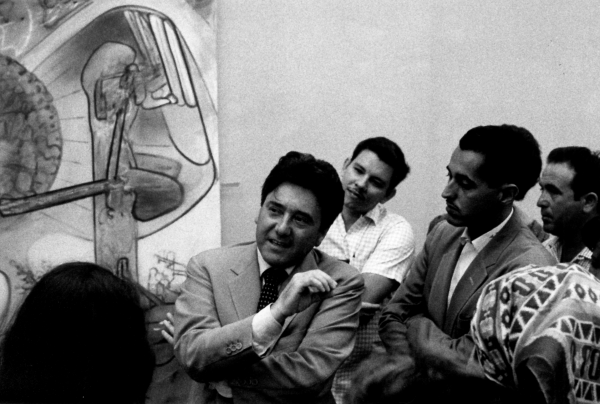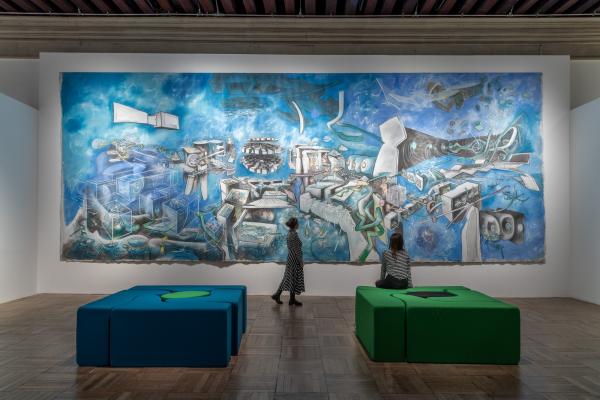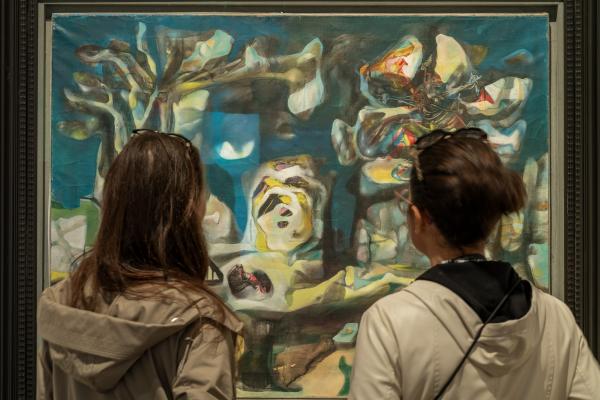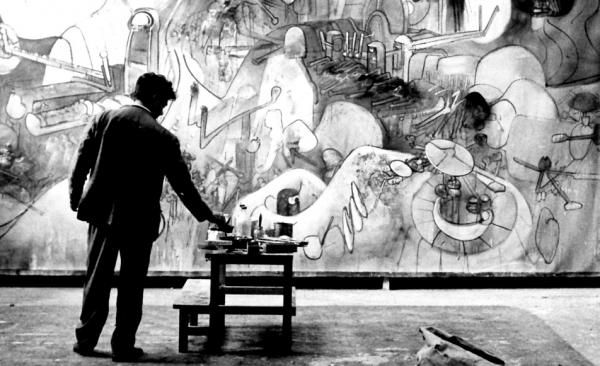 Why an exhibition dedicated to Roberto Matta, now, in Venice? Starting from this question, we worked for over a year, with co-curators Norman Rosenthal and Dawn Ades, on the project now on display in Ca' Pesaro. Matta's message seemed very topical to us right from the start, even though his genius was not always fully recognised in the past and, in the last century, his critical fortunes have experienced ups and downs.
Why an exhibition dedicated to Roberto Matta, now, in Venice? Starting from this question, we worked for over a year, with co-curators Norman Rosenthal and Dawn Ades, on the project now on display in Ca' Pesaro. Matta's message seemed very topical to us right from the start, even though his genius was not always fully recognised in the past and, in the last century, his critical fortunes have experienced ups and downs.
Celebrating Matta today is, first and foremost, a matter of re-establishing a link between the Chilean-born artist, later a citizen of the world, and the current of Surrealism whose Manifesto's centenary has been celebrated in 2024. Irrationality, the unconscious, psychic automatism and deforming matter emerge from Matta's earliest work, which comes after a debut in architecture as an assistant to Le Corbusier. The geometric and constructive component, including in the area of forcing perspective and trespassing into the fourth dimension, distinguishes all his mature production, without losing the echo of his love for poetry and his youthful closeness to Breton and associates.
 The first room of the exhibition does not present Matta's surrealist beginnings but opens with a monumental work from the 1970s, Coïgitum, a famous canvas measuring over 10 metres wide that inspired George Lucas' iconography for Star Wars. The entry into Roberto Matta's ‘world’ thus takes place with a majestic, visionary and over-size work that combines surrealist imagery with architectural construction and the three-dimensional breakthrough of space, in the actuality of a gesture that becomes a manifesto of public art. In front of this is the Malitte seating system, born in 1966 from the friendship between Roberto Matta and Dino Gavina and now taken up by Paradisoterrestre; the extremes of the Chilean artist's story are thus suggested: he was a tireless experimenter, designer, sculptor and draughtsman, and, in the final analysis, a multifaceted magician, precursor of an aesthetic that he liked to define ‘from Leonardo da Vinci to NASA’.
The first room of the exhibition does not present Matta's surrealist beginnings but opens with a monumental work from the 1970s, Coïgitum, a famous canvas measuring over 10 metres wide that inspired George Lucas' iconography for Star Wars. The entry into Roberto Matta's ‘world’ thus takes place with a majestic, visionary and over-size work that combines surrealist imagery with architectural construction and the three-dimensional breakthrough of space, in the actuality of a gesture that becomes a manifesto of public art. In front of this is the Malitte seating system, born in 1966 from the friendship between Roberto Matta and Dino Gavina and now taken up by Paradisoterrestre; the extremes of the Chilean artist's story are thus suggested: he was a tireless experimenter, designer, sculptor and draughtsman, and, in the final analysis, a multifaceted magician, precursor of an aesthetic that he liked to define ‘from Leonardo da Vinci to NASA’.
 The exhibition then winds its way through his entire prolific career and is structured chronologically, starting with the Psychological Morphologies that Matta created in the 1930s and 1940s. On show are extraordinary loans from the Museum of Modern Art in New York, the Nationalgalerie in Berlin, the Art Institute of Chicago, the Tate in London, the Centro de Arte Reina Sofía and the Thyssen-Bornemisza in Madrid, together with an important nucleus of works from private collections and from the collection of Alisée Matta.
The exhibition then winds its way through his entire prolific career and is structured chronologically, starting with the Psychological Morphologies that Matta created in the 1930s and 1940s. On show are extraordinary loans from the Museum of Modern Art in New York, the Nationalgalerie in Berlin, the Art Institute of Chicago, the Tate in London, the Centro de Arte Reina Sofía and the Thyssen-Bornemisza in Madrid, together with an important nucleus of works from private collections and from the collection of Alisée Matta.
Through nine sections, the exhibition embraces the most varied themes of Matta's production, from architecture to science, from literature to linguistics, from political themes to mathematics and humour, according to an interdisciplinary conception of the arts and a creativity that was always open to new technologies and emergencies.
The exhibition addresses the need to fill an unavoidable gap in the critical and visual consciousness of our times. Because it is very difficult to see numerous works by Matta exhibited together, and in Italy only few public institutions preserve his masterpieces. An artist who is often cited by art critics but little known to the general public, Matta thus returns to be recognised as a protagonist of the twentieth century, and precisely in the lagoon city that recognised his value as early as the 1950s. Indeed, the City of Venice was the first Italian institution to accept one of his works and destine it to a public museum when, in 1953, on the occasion of the exhibition Matta 1949-1953 organised by the Galleria del Cavallino and held in the Napoleonic Room of the Correr Museum, it acquired the masterpiece Alba sulla terra for Ca' Pesaro.
 In the exhibition presented today in Venice, with its monumental, visionary and political paintings, sculptures, objects, design projects and sketches, the artist's different souls emerge, as numerous as the influences he received in America, or rather in the Americas, and Europe, and as the courses of the river of his creativity. Within this horizon, a major retrospective of Matta is fully in line with the exhibition programme that the Gallerie di Ca' Pesaro has been pursuing for at least a decade, to rediscover and reread the great masters of the twentieth century in the light of our contemporaneity.
In the exhibition presented today in Venice, with its monumental, visionary and political paintings, sculptures, objects, design projects and sketches, the artist's different souls emerge, as numerous as the influences he received in America, or rather in the Americas, and Europe, and as the courses of the river of his creativity. Within this horizon, a major retrospective of Matta is fully in line with the exhibition programme that the Gallerie di Ca' Pesaro has been pursuing for at least a decade, to rediscover and reread the great masters of the twentieth century in the light of our contemporaneity.
All images: courtesy MUVE-archivio Matta. All artworks © Roberto Matta, by SIAE 2025
